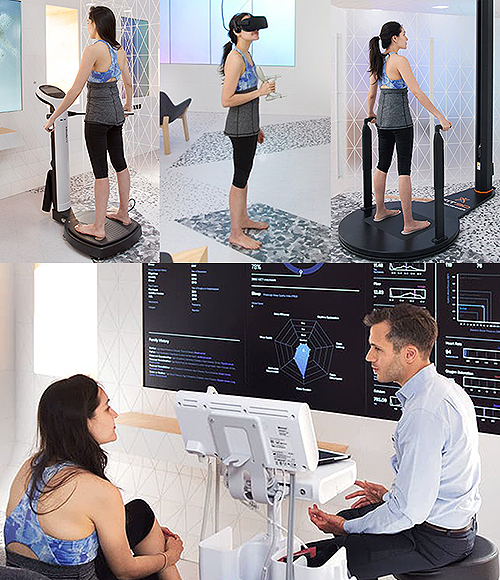Lab100 is designed to be easily upgraded with the latest medical laboratory technologies for tracking patients’ health metrics and risk for chronic diseases
Mount Sinai Hospital and Cactus, a New York City-based design studio, are creating a hybrid clinical laboratory/research lab that uses the latest diagnostic technologies to assess peoples’ health, provide them with an overview of their current condition, and suggest lifestyle changes to prevent future diseases.
Though still under development, Lab100 is an innovative approach to modernizing annual physical/medical check-ups. It was created to empower patients to track and understand their own health metrics and optimize their overall health.
Lab100 looks at an individual’s medical history and measures vital signs, blood analysis, anthropometrics, body composition, cognition, dexterity, strength, and balance. It’s designed to be more extensive than the traditional, annual physical, as well as to support the implementation of preventative measures to avoid disease.
8-Station Clinical Laboratory Built for Future Expansion
Lab100 consists of eight stations that are built on a reconfigurable grid system that ensures the system can easily be upgraded with new technology as it becomes available.
“By definition, no one knows what the future of healthcare is, and neither do we. We made our best initial guess, recognizing that we’re going to change based on the data we collect,” David Stark, MD, the Director and founder of Lab100, told Business Insider. “It may turn out that we jettison some of these stations and put in additional stations.”
Stark is also Chief Medical Officer, Head of HR Data and Analytics, and Managing Director at Morgan Stanley, as well as being the former Medical Director and Assistant Professor of Health System Design and Global Health at the Institute for Next Generation Healthcare (INGH) at the Icahn School of Medicine at Mount Sinai.

“We’re trying to give patients more visibility, not only into their health, but into how healthcare happens with the hope that that visibility engages them as patients,” David Stark, MD, MS (above), Director and founder of Lab100, told Business Insider. Should Lab100 prove successful, it could become a model for future similar medical laboratories nationwide. [Photo copyright: Business Insider.]
Before visiting Lab100 patients complete a pre-visit assessment consisting of standardized medical surveys including medical history, nutritional habits, physical activity, mental health, and sleep habits. With patients’ consent, individual data are shared with a select group of researchers to potentially power new discoveries.
Lab100’s eight stations and their purposes are:
- Station One: A patient’s photograph is taken to put a face with the medical record. The picture also allows researchers to perform more speculative work by extracting facial features and correlating them with health metrics.
- Station Two: The patient’s vital signs (temperature, height, weight, blood pressure, pulse, and oxygen levels) are taken.
- Station Three: A venous blood sample is extracted to measure electrolytes, nutrient, and cholesterol levels. Patients do not need to fast for the blood draw. The blood test is analyzed onsite and the results are available within 30 minutes.
- Station Four: The patient steps on a 3D full-body scanner where a depth-sensing camera scans the body and creates a high-resolution 3D avatar of the individual.
- Station Five: A body composition test is performed using bioelectrical impedance analysis. A small electrical current is run through the body to determine the distribution of water, fat, protein, and minerals in the body and to measure how muscle and fat are distributed throughout the body.
- Station Six: Cognition is analyzed using a traditional pegboard dexterity test. To perform this test, a patient dons headphones and interacts with an Apple iPad to test vocabulary, processing speed, flexibility, episodic memory, and attention.
- Station Seven: The patient’s overall strength is measured by utilizing virtual reality to determine grip strength and push the patient to give their maximum performance.
- Station Eight: The patient steps onto a balance pod to test their balance. An iPod with an accelerometer placed around the patient’s waist measures sway as the individual tries to stay as still as possible.

The entire Lab100 process takes about 90 minutes and is one-on-one between patient and physician. Test results at each of the eight stations are held until the end of the visit where they are cumulatively displayed on a screen for the patient and physician to review. Blood analyses are included in patients’ work-ups. (Photos copyright: Lab100.)
Engaging Patients in Their Own Healthcare
When patients complete their Lab100 experience, they should have a better understanding of their current health and any changes they can make in their lives to improve their health and possibly avoid future disease. The results allow a patient to learn their risks for some diseases and whether interventions—such as changes in diet and exercise—could alter those risks.
“The idea here is not to obsess over every number, but to holistically look at what’s going well, what isn’t going well, and come away with one to three domains that you as the patient want to focus on,” Stark noted.
The initial Lab100 visit serves as a baseline for comparing with future visits to measure improvements as a result of lifestyle changes. It also allows patients to compare their health metrics to others in the same age range.
Lab 100 is still in the testing stages and could be available to the public later this year. It is not intended to be a replacement for primary care and does not diagnose disease. It is intended to serve as a complement to a traditional office visit and focuses on preventative measures to avoid illness. The researchers involved in the Lab100 project hope the environment can ultimately be used to produce new diagnostics, therapeutics, and tools for measuring health.
—JP Schlingman
Related Information:



